Individual Critical Reflection on Group Presentation Experience
VerifiedAdded on 2020/06/05
|5
|1057
|65
Journal and Reflective Writing
AI Summary
This assignment is an individual critical reflection on a group presentation experience. The student reflects on the process of working in a team, highlighting the initial chaos in defining roles and responsibilities, and the eventual appointment of a team leader to streamline the process. The reflection draws on Bruce Tuckman's stages of group development (Forming, Storming, Norming) to analyze the team's evolution, emphasizing the importance of effective communication and individual contributions. The student discusses personal growth in overcoming communication issues and the development of team spirit, as well as the importance of supporting each other. The conclusion emphasizes the value of teamwork and overcoming challenges through the combined knowledge, skills, and commitment of each team member. The reflection also references the STAR team model and the importance of good team leadership.
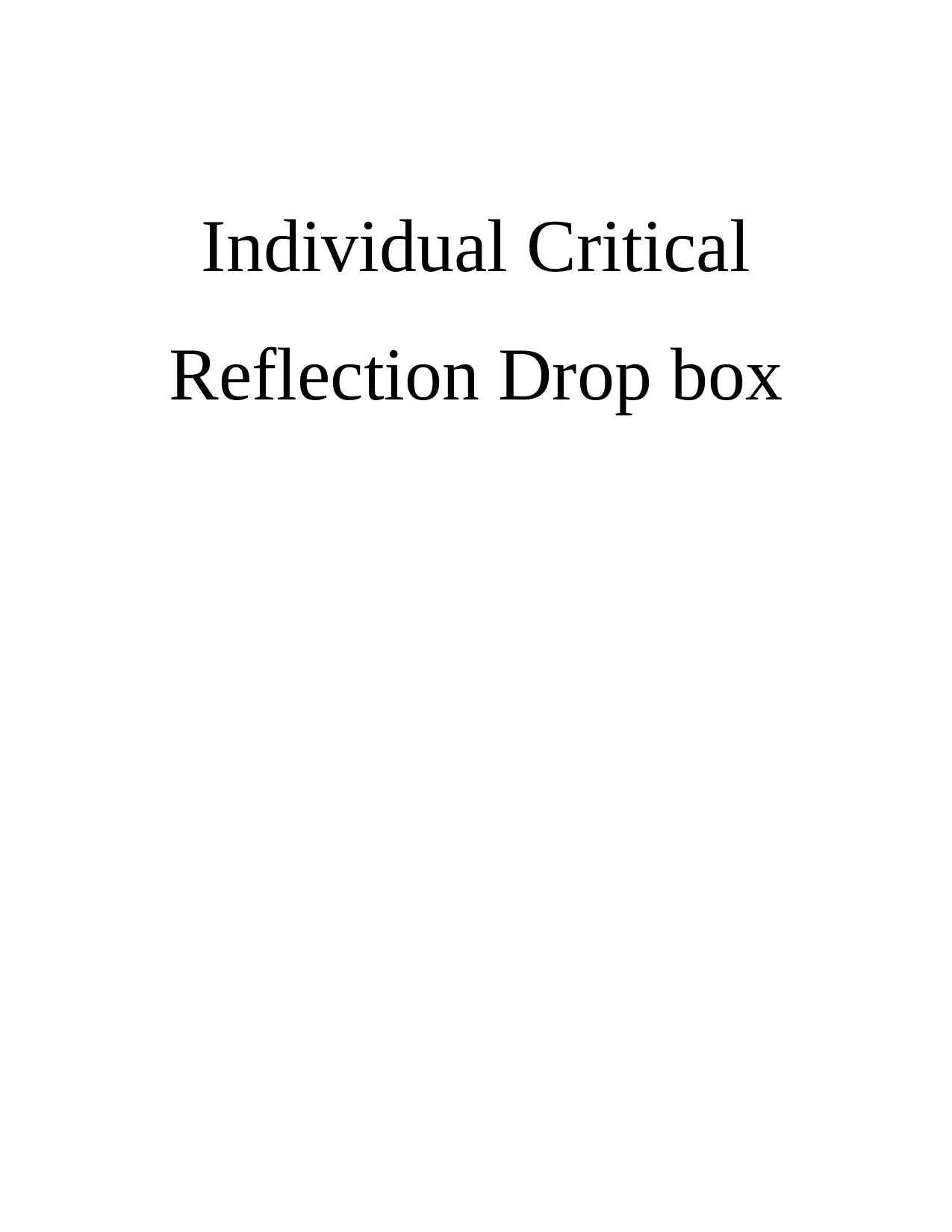
Individual Critical
Reflection Drop box
Reflection Drop box
Paraphrase This Document
Need a fresh take? Get an instant paraphrase of this document with our AI Paraphraser
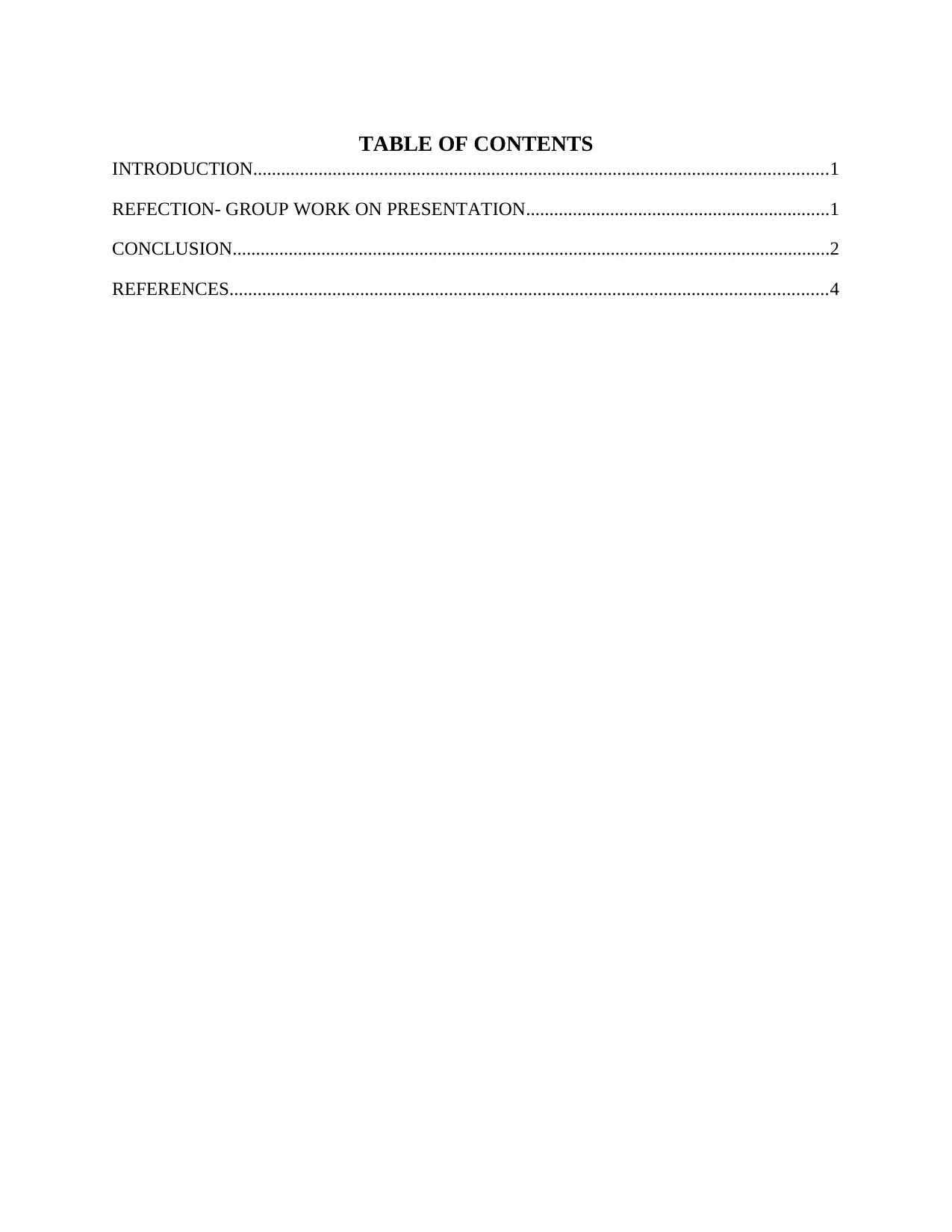
TABLE OF CONTENTS
INTRODUCTION...........................................................................................................................1
REFECTION- GROUP WORK ON PRESENTATION.................................................................1
CONCLUSION................................................................................................................................2
REFERENCES................................................................................................................................4
INTRODUCTION...........................................................................................................................1
REFECTION- GROUP WORK ON PRESENTATION.................................................................1
CONCLUSION................................................................................................................................2
REFERENCES................................................................................................................................4
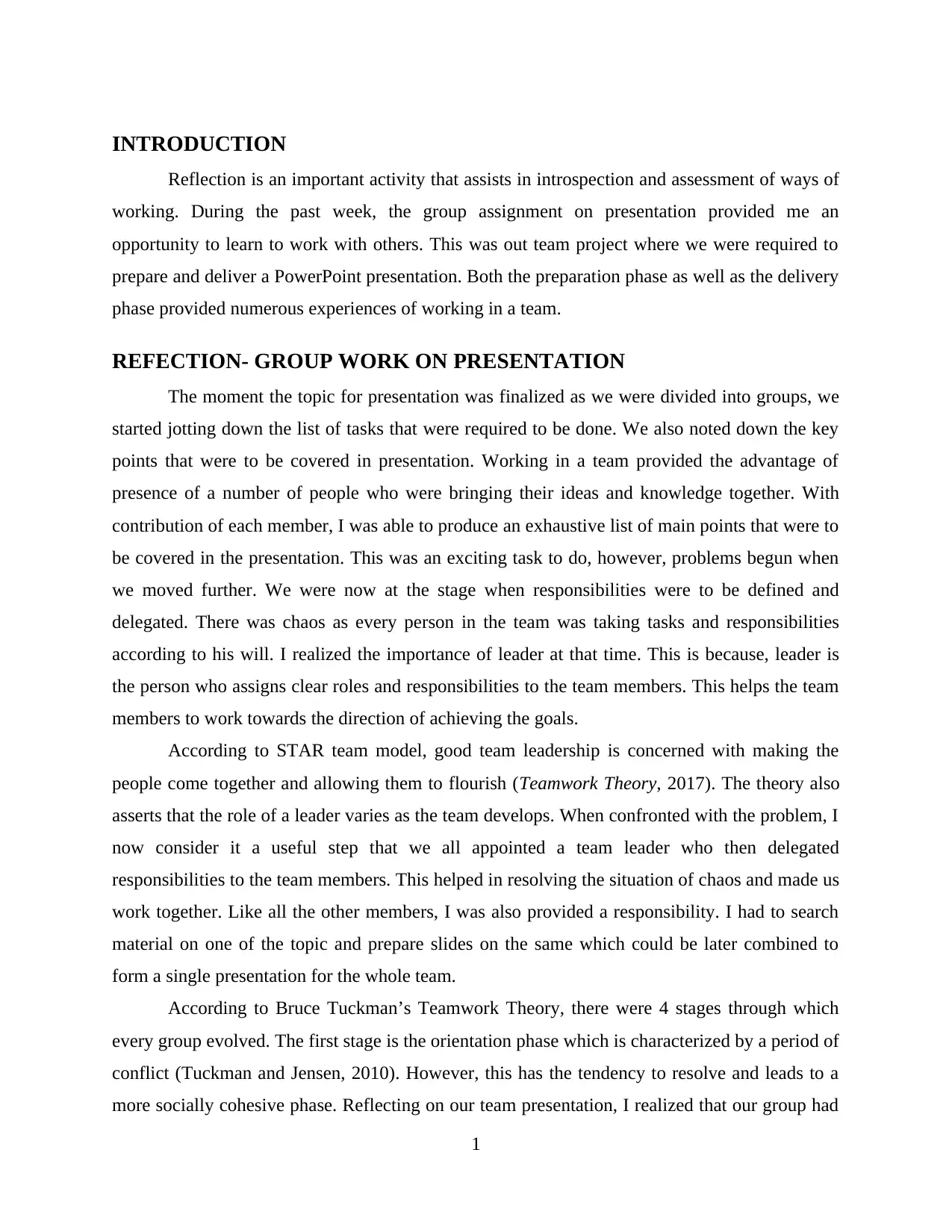
INTRODUCTION
Reflection is an important activity that assists in introspection and assessment of ways of
working. During the past week, the group assignment on presentation provided me an
opportunity to learn to work with others. This was out team project where we were required to
prepare and deliver a PowerPoint presentation. Both the preparation phase as well as the delivery
phase provided numerous experiences of working in a team.
REFECTION- GROUP WORK ON PRESENTATION
The moment the topic for presentation was finalized as we were divided into groups, we
started jotting down the list of tasks that were required to be done. We also noted down the key
points that were to be covered in presentation. Working in a team provided the advantage of
presence of a number of people who were bringing their ideas and knowledge together. With
contribution of each member, I was able to produce an exhaustive list of main points that were to
be covered in the presentation. This was an exciting task to do, however, problems begun when
we moved further. We were now at the stage when responsibilities were to be defined and
delegated. There was chaos as every person in the team was taking tasks and responsibilities
according to his will. I realized the importance of leader at that time. This is because, leader is
the person who assigns clear roles and responsibilities to the team members. This helps the team
members to work towards the direction of achieving the goals.
According to STAR team model, good team leadership is concerned with making the
people come together and allowing them to flourish (Teamwork Theory, 2017). The theory also
asserts that the role of a leader varies as the team develops. When confronted with the problem, I
now consider it a useful step that we all appointed a team leader who then delegated
responsibilities to the team members. This helped in resolving the situation of chaos and made us
work together. Like all the other members, I was also provided a responsibility. I had to search
material on one of the topic and prepare slides on the same which could be later combined to
form a single presentation for the whole team.
According to Bruce Tuckman’s Teamwork Theory, there were 4 stages through which
every group evolved. The first stage is the orientation phase which is characterized by a period of
conflict (Tuckman and Jensen, 2010). However, this has the tendency to resolve and leads to a
more socially cohesive phase. Reflecting on our team presentation, I realized that our group had
1
Reflection is an important activity that assists in introspection and assessment of ways of
working. During the past week, the group assignment on presentation provided me an
opportunity to learn to work with others. This was out team project where we were required to
prepare and deliver a PowerPoint presentation. Both the preparation phase as well as the delivery
phase provided numerous experiences of working in a team.
REFECTION- GROUP WORK ON PRESENTATION
The moment the topic for presentation was finalized as we were divided into groups, we
started jotting down the list of tasks that were required to be done. We also noted down the key
points that were to be covered in presentation. Working in a team provided the advantage of
presence of a number of people who were bringing their ideas and knowledge together. With
contribution of each member, I was able to produce an exhaustive list of main points that were to
be covered in the presentation. This was an exciting task to do, however, problems begun when
we moved further. We were now at the stage when responsibilities were to be defined and
delegated. There was chaos as every person in the team was taking tasks and responsibilities
according to his will. I realized the importance of leader at that time. This is because, leader is
the person who assigns clear roles and responsibilities to the team members. This helps the team
members to work towards the direction of achieving the goals.
According to STAR team model, good team leadership is concerned with making the
people come together and allowing them to flourish (Teamwork Theory, 2017). The theory also
asserts that the role of a leader varies as the team develops. When confronted with the problem, I
now consider it a useful step that we all appointed a team leader who then delegated
responsibilities to the team members. This helped in resolving the situation of chaos and made us
work together. Like all the other members, I was also provided a responsibility. I had to search
material on one of the topic and prepare slides on the same which could be later combined to
form a single presentation for the whole team.
According to Bruce Tuckman’s Teamwork Theory, there were 4 stages through which
every group evolved. The first stage is the orientation phase which is characterized by a period of
conflict (Tuckman and Jensen, 2010). However, this has the tendency to resolve and leads to a
more socially cohesive phase. Reflecting on our team presentation, I realized that our group had
1
⊘ This is a preview!⊘
Do you want full access?
Subscribe today to unlock all pages.

Trusted by 1+ million students worldwide
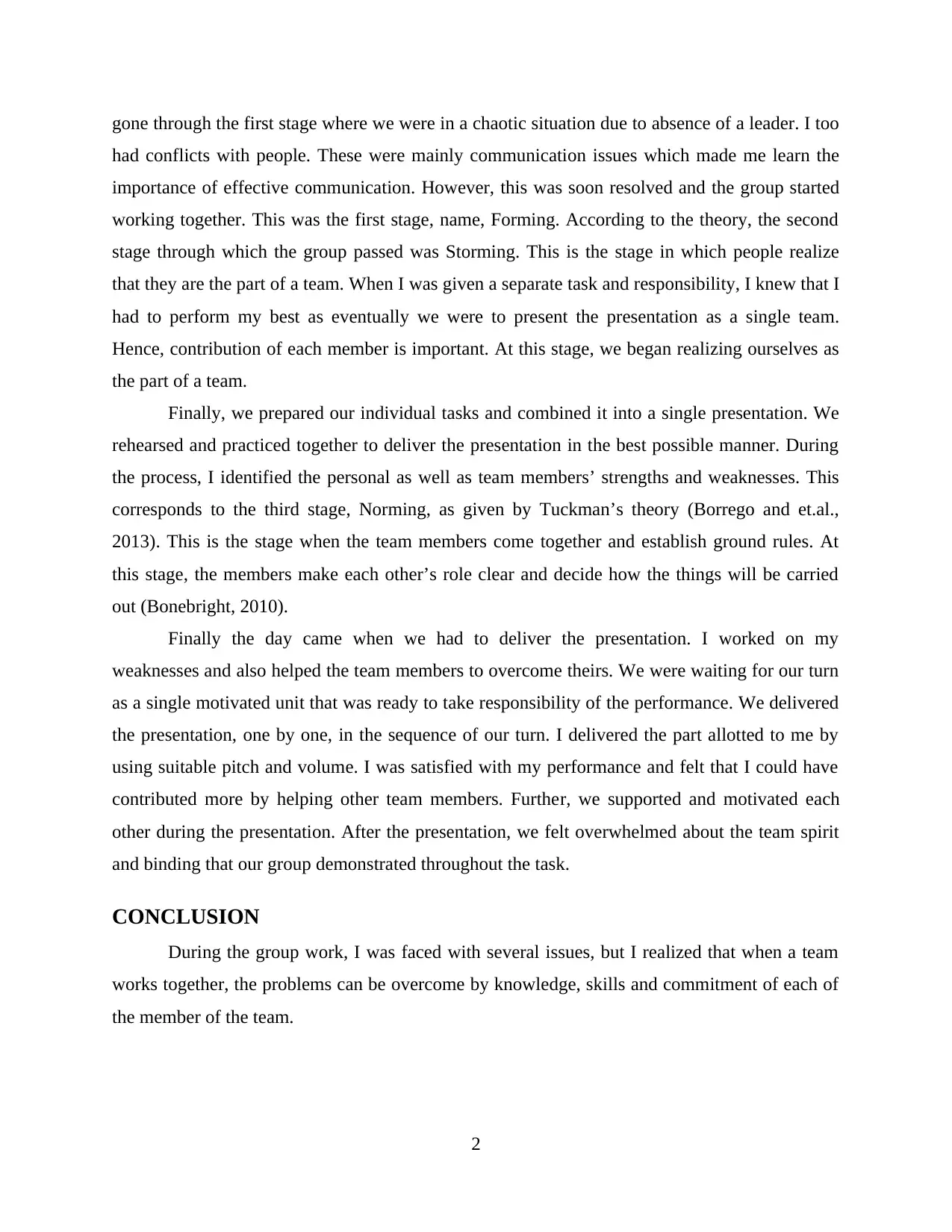
gone through the first stage where we were in a chaotic situation due to absence of a leader. I too
had conflicts with people. These were mainly communication issues which made me learn the
importance of effective communication. However, this was soon resolved and the group started
working together. This was the first stage, name, Forming. According to the theory, the second
stage through which the group passed was Storming. This is the stage in which people realize
that they are the part of a team. When I was given a separate task and responsibility, I knew that I
had to perform my best as eventually we were to present the presentation as a single team.
Hence, contribution of each member is important. At this stage, we began realizing ourselves as
the part of a team.
Finally, we prepared our individual tasks and combined it into a single presentation. We
rehearsed and practiced together to deliver the presentation in the best possible manner. During
the process, I identified the personal as well as team members’ strengths and weaknesses. This
corresponds to the third stage, Norming, as given by Tuckman’s theory (Borrego and et.al.,
2013). This is the stage when the team members come together and establish ground rules. At
this stage, the members make each other’s role clear and decide how the things will be carried
out (Bonebright, 2010).
Finally the day came when we had to deliver the presentation. I worked on my
weaknesses and also helped the team members to overcome theirs. We were waiting for our turn
as a single motivated unit that was ready to take responsibility of the performance. We delivered
the presentation, one by one, in the sequence of our turn. I delivered the part allotted to me by
using suitable pitch and volume. I was satisfied with my performance and felt that I could have
contributed more by helping other team members. Further, we supported and motivated each
other during the presentation. After the presentation, we felt overwhelmed about the team spirit
and binding that our group demonstrated throughout the task.
CONCLUSION
During the group work, I was faced with several issues, but I realized that when a team
works together, the problems can be overcome by knowledge, skills and commitment of each of
the member of the team.
2
had conflicts with people. These were mainly communication issues which made me learn the
importance of effective communication. However, this was soon resolved and the group started
working together. This was the first stage, name, Forming. According to the theory, the second
stage through which the group passed was Storming. This is the stage in which people realize
that they are the part of a team. When I was given a separate task and responsibility, I knew that I
had to perform my best as eventually we were to present the presentation as a single team.
Hence, contribution of each member is important. At this stage, we began realizing ourselves as
the part of a team.
Finally, we prepared our individual tasks and combined it into a single presentation. We
rehearsed and practiced together to deliver the presentation in the best possible manner. During
the process, I identified the personal as well as team members’ strengths and weaknesses. This
corresponds to the third stage, Norming, as given by Tuckman’s theory (Borrego and et.al.,
2013). This is the stage when the team members come together and establish ground rules. At
this stage, the members make each other’s role clear and decide how the things will be carried
out (Bonebright, 2010).
Finally the day came when we had to deliver the presentation. I worked on my
weaknesses and also helped the team members to overcome theirs. We were waiting for our turn
as a single motivated unit that was ready to take responsibility of the performance. We delivered
the presentation, one by one, in the sequence of our turn. I delivered the part allotted to me by
using suitable pitch and volume. I was satisfied with my performance and felt that I could have
contributed more by helping other team members. Further, we supported and motivated each
other during the presentation. After the presentation, we felt overwhelmed about the team spirit
and binding that our group demonstrated throughout the task.
CONCLUSION
During the group work, I was faced with several issues, but I realized that when a team
works together, the problems can be overcome by knowledge, skills and commitment of each of
the member of the team.
2
Paraphrase This Document
Need a fresh take? Get an instant paraphrase of this document with our AI Paraphraser
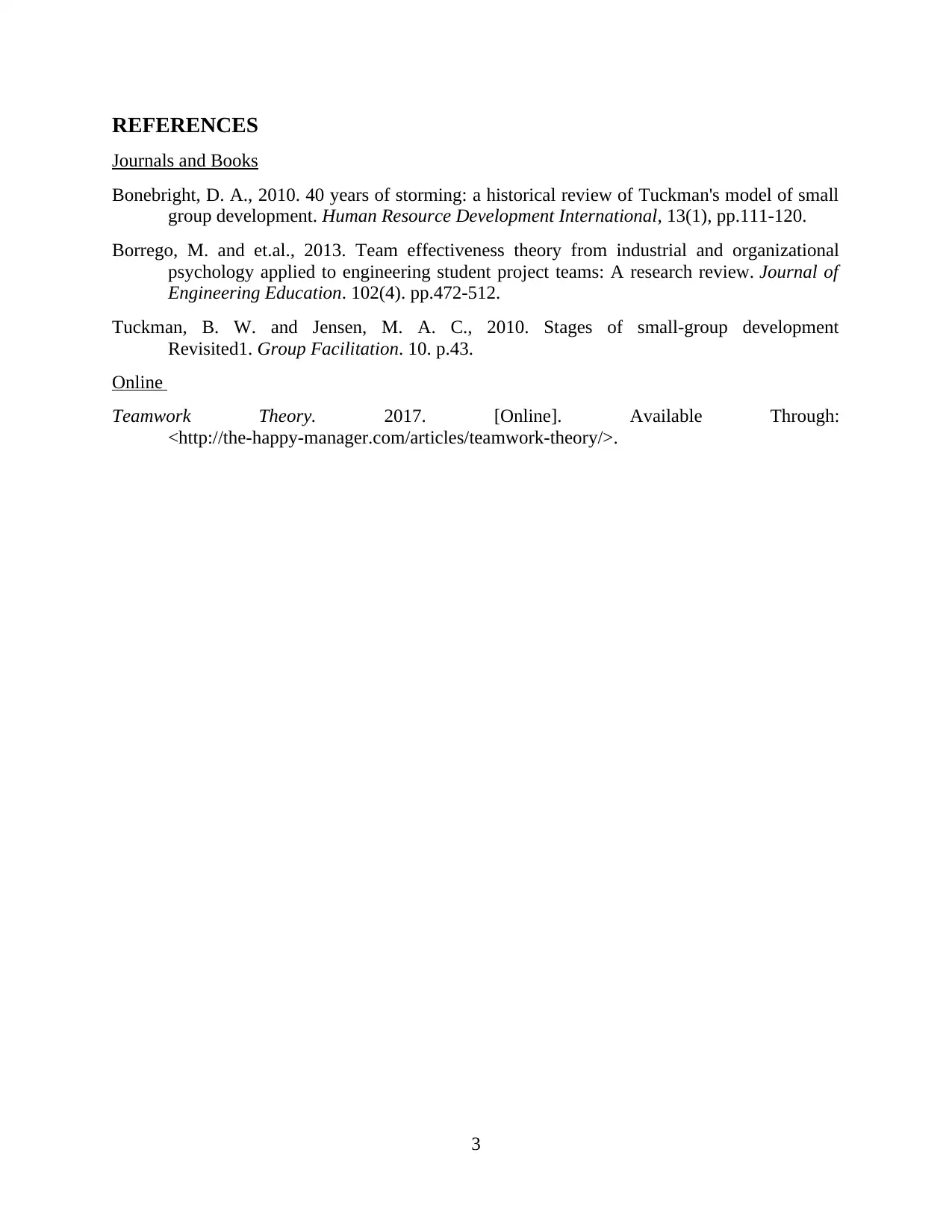
REFERENCES
Journals and Books
Bonebright, D. A., 2010. 40 years of storming: a historical review of Tuckman's model of small
group development. Human Resource Development International, 13(1), pp.111-120.
Borrego, M. and et.al., 2013. Team effectiveness theory from industrial and organizational
psychology applied to engineering student project teams: A research review. Journal of
Engineering Education. 102(4). pp.472-512.
Tuckman, B. W. and Jensen, M. A. C., 2010. Stages of small-group development
Revisited1. Group Facilitation. 10. p.43.
Online
Teamwork Theory. 2017. [Online]. Available Through:
<http://the-happy-manager.com/articles/teamwork-theory/>.
3
Journals and Books
Bonebright, D. A., 2010. 40 years of storming: a historical review of Tuckman's model of small
group development. Human Resource Development International, 13(1), pp.111-120.
Borrego, M. and et.al., 2013. Team effectiveness theory from industrial and organizational
psychology applied to engineering student project teams: A research review. Journal of
Engineering Education. 102(4). pp.472-512.
Tuckman, B. W. and Jensen, M. A. C., 2010. Stages of small-group development
Revisited1. Group Facilitation. 10. p.43.
Online
Teamwork Theory. 2017. [Online]. Available Through:
<http://the-happy-manager.com/articles/teamwork-theory/>.
3
1 out of 5
Related Documents
Your All-in-One AI-Powered Toolkit for Academic Success.
+13062052269
info@desklib.com
Available 24*7 on WhatsApp / Email
![[object Object]](/_next/static/media/star-bottom.7253800d.svg)
Unlock your academic potential
Copyright © 2020–2025 A2Z Services. All Rights Reserved. Developed and managed by ZUCOL.




